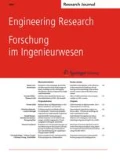Abstract
When a second law analysis is applied to a heat transfer process, the influence of boundary conditions on the chosen assessment criterion is of major importance. In this paper, three different sets of boundary conditions and three different assessment criteria based on the entropy generation are applied to a plate heat exchanger. The influence of the boundary conditions on the device’s operation and on the usefulness of the assessment criteria is discussed.
Zusammenfassung
Bei der Bewertung eines Wärmeübergangs nach Kriterien, die auf dem zweiten Hauptsatz der Thermodynamik basieren, spielt der Einfluss der gewählten Randbedingungen auf diese Kriterien eine wichtige Rolle. In diesem Artikel werden drei verschiedene Sätze von Randbedingungen und drei verschiedene Bewertungskriterien auf einen Plattenwärmeübertrager angewandt. Es wird diskutiert, wie sich die verschiedenen Randbedingungen auf den Betrieb des Apparates und die Aussagekraft der Bewertungskriterien auswirken.












Similar content being viewed by others
References
Bejan A (1977) The concept of irreversibility in heat exchanger design: counterflow heat exchangers for gas-to-gas applications. J Heat Transf 99(3):374–380
Bejan A (1996) Entropy generation minimization: the method of thermodynamic optimization of finite-size systems and finite-time processes. CRC Press, Boca Raton
Fakheri A (2010) Second law analysis of heat exchangers. J Heat Transf 132(11):111802
Herwig H (2012) The role of entropy generation in momentum and heat transfer processes. J Heat Transf 134(3):031003
Hesselgreaves JE (2000) Rationalisation of second law analysis of heat exchangers. Int J Heat Mass Transf 43(22):4189–4204
Ogiso K (2003) Duality of heat exchanger performance in balanced counter-flow systems. J Heat Transf 125(3):530–532
VDI-Wärmeatlas (2006) VDI-Wärmeatlas. Berechnungsunterlagen für Druckverlust, Wärme- und Stoffübergang. Springer, Berlin, 10., bearb u erw a edition
Witte LC, Shamsundar N (1983) A thermodynamic efficiency concept for heat exchange devices. J Eng Power 105(1):199–203
Xu ZM, Yang S, Chen Z (1996) A modified entropy generation number for heat exchangers. J Therm Sci 5(4):257–263
Author information
Authors and Affiliations
Corresponding author
Rights and permissions
About this article
Cite this article
Redecker, C., Herwig, H. Assessing heat transfer processes: a critical view at criteria based on the second law of thermodynamics. Forsch Ingenieurwes 76, 77–85 (2012). https://doi.org/10.1007/s10010-012-0156-9
Received:
Published:
Issue Date:
DOI: https://doi.org/10.1007/s10010-012-0156-9




